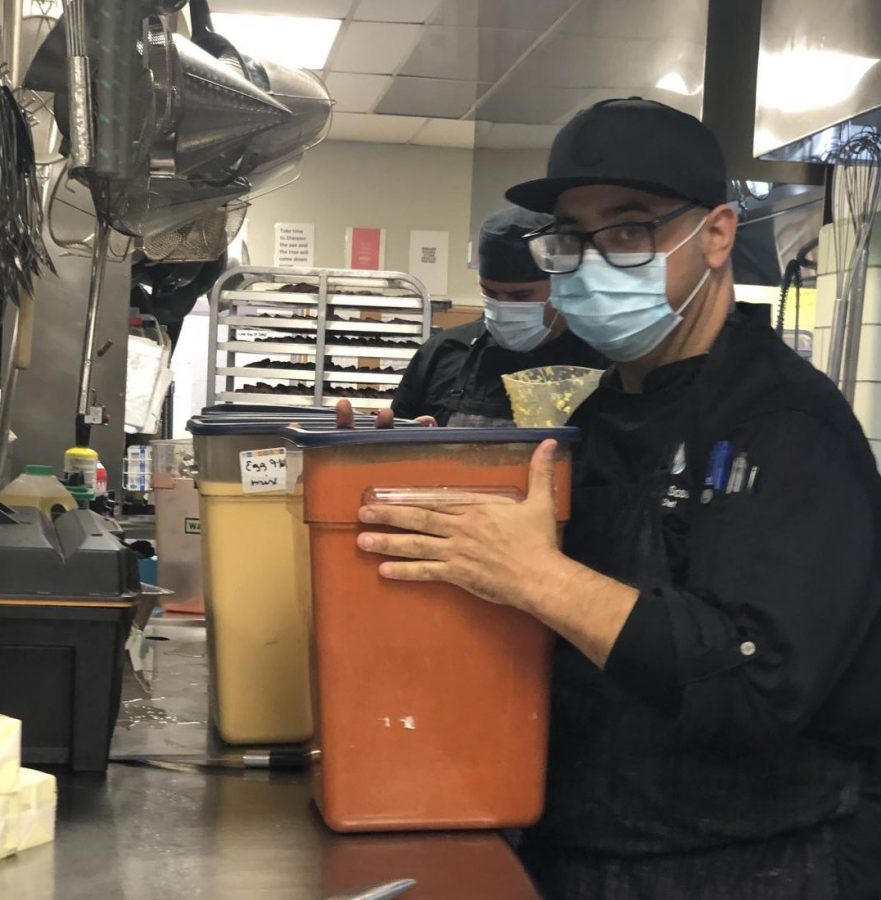Behind-the-Scenes: Everything You Never Knew About the School Lunch
As you begin to awake in the morning, the FLIK staff have already arrived at school. They immediately head to work, combining and organizing ingredients to fill famished students. It’s only after lunchtime when the day’s workload comes to a sudden halt. Even so, most don’t consider the amount of preparation FLIK does to supply us with meals.
Each day, it takes a small army of FLIK workers to feed students throughout campus. “There’s probably about sixteen cooks that are on-hand—that’s their sole position [in Malone],” says Chef Ihara, the executive chef at Malone dining hall. “We have salad bar/deli people that work in the coolers that handle the cold prep and the deli station. I have dishwashers here, and I have bakers that handle all of the pastries, cookies, and stuff of that nature.” The company also has managers, but only about one or two are located in each building. Some staff also manage feeding children at the Westminster Nursery, Guan Café in Barge Commons, as well as Hawkins’ Brewer Café.
At Malone, the staff feed approximately 1,900 students each day. However, the number of students may vary depending on the popularity of the meal being served. “Being that this is an all-you-can-eat, that number of 1,900 students sometimes can grow to 25–2,600 students, depending on whether we think they’re going to come back in line two, three, four times,” says Chef Ihara. “Sometimes that number we’re feeding is 3,000 or 4,000, just because that ‘s that one portion, and then you multiply that by how many times they’re coming back.”
Even with a brimming schedule, the kitchen still has to remain detailed and coordinated. The management of Flik’s schedule is somewhat like a dance routine. “Everybody comes in at about 6 a.m., and my team breaks off and starts delving into lunch. We’re getting orders pretty much every day of the week, so at any given time, we’re prepping for tomorrow. The volume is so massive we have to flip our ovens over and over again,” said Chef Ihara. Simple food items, such as a bagel pizza, can take up to three or four days to make due to the enormous amount.
Depending on the building, the food items can differ.
The nursery’s menu consists mainly of simple products that are easier to eat for the younger students. “There are about a hundred people that we feed in the nursery,” says Chef Ihara. “It’s a simplified menu according to some of the nutritional guidelines and restrictions that they have over there. Certain things we can’t serve because the littler students don’t quite have the dexterity.”
Guan Café, however, serves more complex café items exclusively for highschool students. “We serve assorted pastries . . . We have bacon, egg, and cheese croissants, and ham, egg, and cheese croissants,” says Jason Trevorton, the manager of Guan Café. “There are also different types of snacks—brownies, hummus cups, macaroons, and different types of beverages. They’re all canned beverages, so you can take them to-go. There are coffee options . . . we serve pretty much anything a normal café would serve.”
The Guan Café staff are also trained differently, unlike the typical cafeteria staff. Their knowledge lies in more of the barista category. “The difference would be the amount of training they get and the type of training,” says Treverton. “We’re teaching more coffee drinks up here, and some of those staff members down there [Malone] haven’t had the opportunity to learn how to make coffee drinks. Daria and Karen [employees at Guan Café] have both worked in the café, serving on the line. Karen has some expertise in allergy training. You’ll see some other people coming up to train, if we’re teaching people how to do certain drinks, or how to steam certain milks, and stuff like that. Having a professional and spirited attitude are extremely important, as well. So, making sure that there are people up here [Guan Café] who are energetic, and engage with the customers, would continue with professionalism.”
The primary objective of Flik is to ensure that students are receiving proper nutrition through healthy meals. However, the way students prefer to eat doesn’t always align with Flik’s philosophy. “The majority of the students here would eat chicken fingers every day if I were to serve that to them, or would have fried food if I were to serve that to them. The guidelines for the company that I represent is we’re not doing more than one fried item a week, normally,” says Chef Ihara. “If I had to change something, it would be better communication between what students want, and what my company represents, and trying to find the middle ground between the two.”


